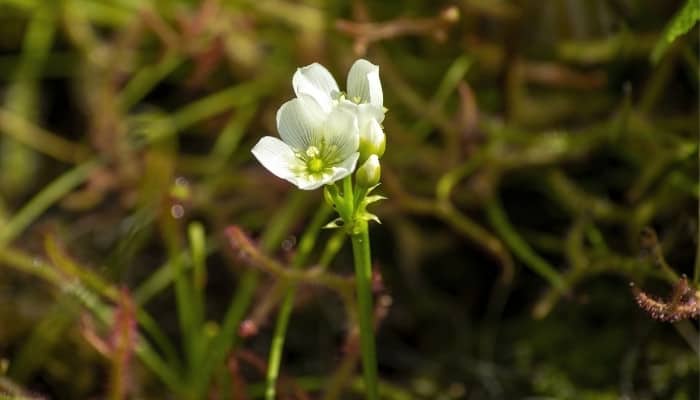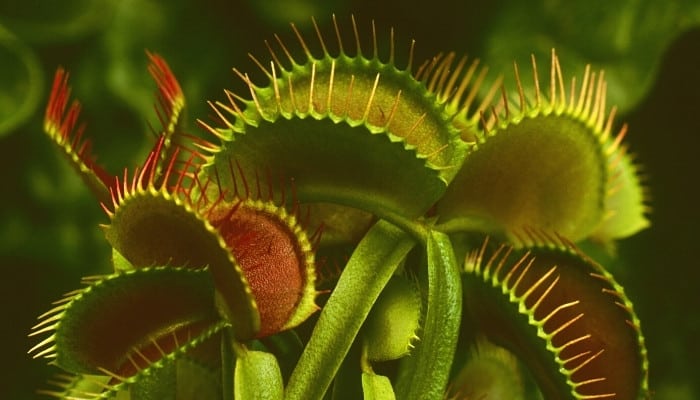The Venus fly trap is an entertaining and distinct plant that obtains its nutrients by consuming insects. While it has been described as a challenging plant to maintain, the key is simply understanding its care requirements.
Once you learn how to properly care for a Venus fly trap, it may even reward you with flowers!
Do venus fly traps flower? Venus fly traps will produce a flower stalk in the spring after they come out of dormancy. Producing flowers takes a lot of energy and resources. Because of this, many Venus fly traps cannot recover after producing flowers and will die within a couple of months.
Flowering doesn’t always kill a Venus fly trap plant. It is important to make sure that the plant has a strong root system and is in great health.
Feeding your Venus fly trap with insects during flowering will also make sure it has all the nutrients it needs to recover.
Venus Fly Trap Care: The Basics
Venus fly traps do have some care parameters that are different from most plants.
Once you understand how to properly care for a Venus fly trap, you will have no problem growing a robust and healthy plant.
Container & Soil
Venus fly traps require a low-nutrient growing medium with good drainage. Peat moss and sphagnum moss are two of the best options.
You can also add perlite to increase drainage and soil aeration. Another option is to use a potting mix designed specifically for carnivorous plants – this will yield excellent results.
Use a container with plenty of drainage holes to prevent the roots from sitting in water. Ideally, the container will be at least 4 inches deep to allow plenty of space for root growth.
Avoid unglazed clay pots because they can leach minerals into the soil that are toxic to Venus fly traps.
Watering
One of the biggest mistakes that people make when caring for a Venus fly trap is watering it with tap water.
These plants are particularly sensitive to chemicals and minerals in the water. It is best to use distilled, reverse osmosis, or rain water for your Venus fly trap.
Never allow the Venus fly trap’s soil to dry out. These plants need to have slightly moist soil at all times.
Bottom watering is a great way to allow the soil to soak up the right amount of water. Always allow the container to drain fully after each watering.
Light Requirements
Venus fly traps require a lot of sunlight and are therefore better suited for living outdoors. Aim for at least four hours of direct sunlight per day, but six to eight hours is ideal.
A sunny window or a grow light (like this one with four adjustable arms, 10 brightness settings, and three light modes) will be necessary to keep your Venus fly trap indoors.
Temperature & Humidity Needs
Venus fly trap foliage is pretty adaptable to any temperature. However, the roots of the plant can be harmed by extremely high temperatures (above 95 degrees Fahrenheit) and below freezing.
Using a large pot with mulch can keep soil temperatures lower during the heat of summer.
Many people think that Venus fly traps dwell in swamps, but this is not correct. They prefer moderate humidity with plenty of airflow to prevent mold and fungus growth.
Feeding Venus Fly Trap
Believe it or not, Venus fly traps do not need to eat insects to survive. Just like all plants, they can create the energy they need through photosynthesis.
For ideal health, your Venus fly trap should eat a few insects per month.
It is best to have your plant outside where it can catch its food. Venus fly traps do not eat enough to be considered a good form of pest control inside your home.
If you are feeding your Venus fly trap by hand, use small insects with soft bodies.
Removing Dead Leaves & Traps
Before dormancy, it is normal for the outer and larger traps to die off. You can use sterilized scissors to remove these dead traps and leaves.
Throughout the rest of the year, prune off any dead foliage as needed.
Flowering
When coming out of dormancy in the spring, a healthy Venus fly trap will put up a single flower stalk. Most plants require at least six weeks of dormancy to be able to produce a flower stalk.
Growing flowers pulls a lot of energy and nutrients from the plant. This means that younger and less healthy plants can die off after producing flowers.
When Do Venus Fly Traps Flower?

Venus fly traps will flower once a year in the spring when they are coming out of dormancy.
Why Is My Venus Fly Trap Flowering in Winter?
If you live in a warmer climate that does not experience drastic daylight and temperature changes in winter, your plant may have a shorter dormancy period.
This can cause “spring” to come early for your Venus fly trap, and it will flower in winter.
How Long Does It Take a Venus Fly Trap To Flower?
Venus fly traps will not produce flowers until the rhizome is large enough, usually, at least 1-2 years old.
How Often Do Venus Fly Traps Flower?
Venus fly traps will flower once a year in the spring. Each plant puts up a single flower stalk.
Why Is My Venus Fly Trap Blooming?
If your Venus fly trap is blooming, that means it is a large, healthy plant. Unhealthy and young plants will not have the resources to produce flowers.
What Does a Venus Fly Trap Flower Look Like?
A Venus fly trap flower is small and white with five petals. Each flower stalk will have one to a few flowers on it.
Should I Let My Venus Fly Trap Flower?
It is not recommended to let your Venus fly trap flower. Producing flowers pulls energy and nutrients from the plant and can end up killing the plant.
Simply cut the new flower stalk off at the base of the plant with a clean, sterilized pair of scissors.
How Do I Cut the Flowers Off My Venus Fly Trap?
As soon as you see a flower stalk growing, it is recommended to cut it off at the base. This will prevent your plant from wasting resources on growing the flowers.
Do Venus Fly Traps Die After Flowering?
For many uneducated growers, their Venus fly traps end up dying after flowering. It is extremely taxing on the plant to produce flowers, and the plant usually does not recover.
Removing flower stalks as soon as they appear may extend the life of your plant.
What Happens After Venus Fly Trap Flowers?
The flowers will die off, and you can collect the seeds (if the flowers were pollinated). Use sterile scissors to remove the flower stalk.
It is important to maintain ideal care conditions for your plant while it recovers from blooming. Feeding insects during this time will help your plant get all the nutrients it needs.
Are Venus Fly Traps Self-Pollinating?
Venus fly trap flowers can self-pollinate. However, it is recommended to cross-pollinate the plants for healthier seeds with higher germination rates.
Conclusion
Venus fly traps are interesting enough without flowers. It is often not worth it to allow your Venus fly trap to produce flowers.
The flowers pull too much energy from the plant and can be more detrimental than beautiful.

